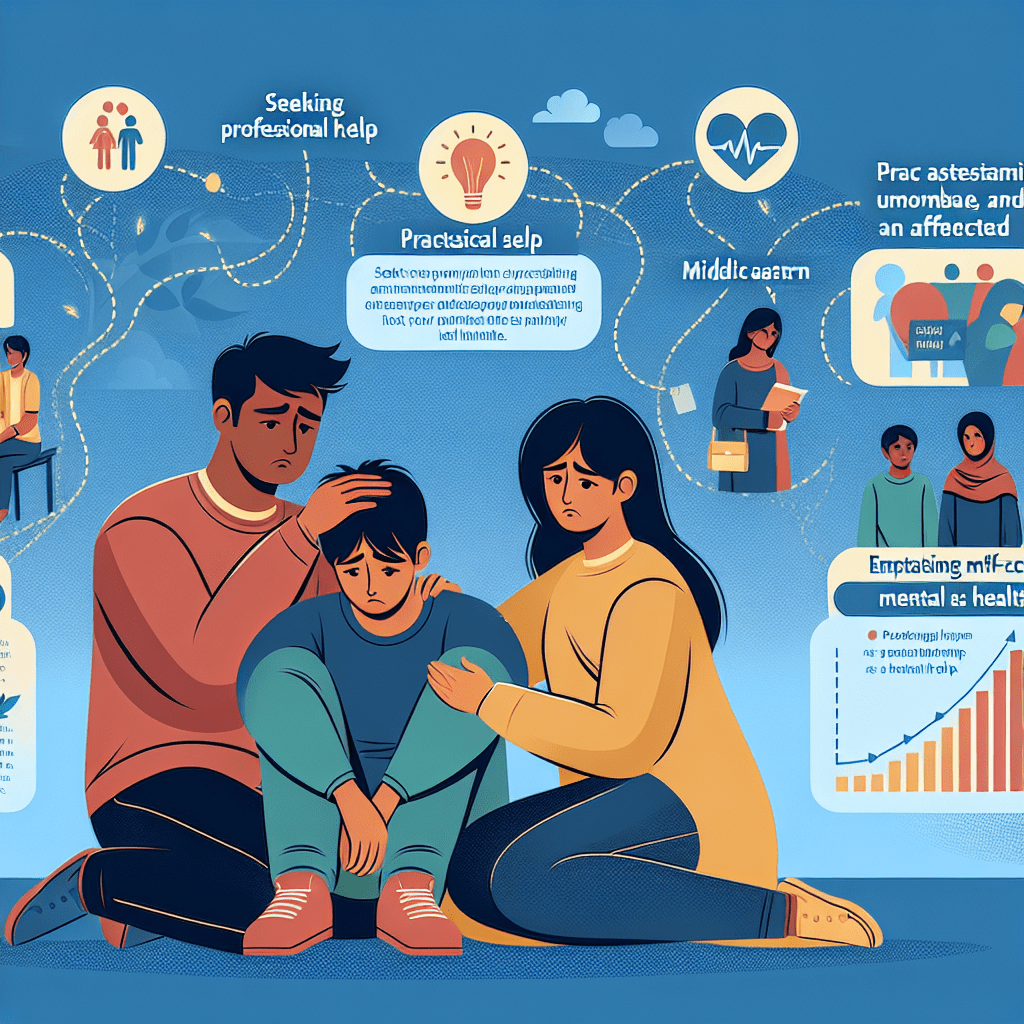Get your free Book Here

The Ripple Effect: Understanding How Family Mental Health Influences Everyone in the Household
As a careworker, I often witness the profound interconnectedness of family dynamics when it comes to mental health. It is incredibly rewarding to support families in their journey toward wellness, but I also see the challenges that arise when mental health issues are present. In this post, I want to explore the ripple effect of mental health within families — how it can influence not just the individual struggling but also every member of the household. The following chapters will delve into aspects of family mental health, from understanding what it means to be mentally healthy, how mental well-being can ripple through relationships, and the steps we can take to create a healthier environment for everyone involved.
Chapter 1: What is Mental Health?
Understanding mental health is the first step toward addressing its impact on families. Mental health includes our emotional, psychological, and social well-being. It affects how we think, feel, and act, as well as how we handle stress, relate to others, and make choices. Everyone has mental health, just as everyone has physical health, and it can fluctuate over time due to various factors such as life experiences, genetics, and environment.
In a family context, mental health is not just an individual issue. When one family member struggles with mental health, it can create a ripple effect that touches the lives of everyone in the household. For example, if a parent is experiencing depression, the child may feel neglected or anxious, and the partner may feel overwhelmed by both their own emotional responses and the demands of parenting or caregiving.
Chapter 2: Recognizing the Signs of Mental Distress
The next step in understanding the ripple effect of mental health in families is to recognize when mental distress is present. Signs may manifest in various forms, including changes in mood, behavior, and physical health. Within a family, signs can look different depending on the individual’s age and personality.
- Children: Young children may exhibit regression in behavior, withdrawal, or become irritable.
- Teens: Teenagers may become more rebellious, experience mood swings, or engage in risky behaviors.
- Adults: Adults may show signs of fatigue, changes in appetite, social withdrawal, or irritability.
The key takeaway is that each family member’s mental health affects others in the household. A family member’s emotional struggles can cause anxiety or confusion in others, creating a complex web of reactions and interactions that can further entrench the issues at hand.
Chapter 3: The Impact of Stigma
Stigma surrounding mental health issues can intensify the ripple effect within families. In many cultures, mental health issues are shrouded in misunderstanding and can often lead to feelings of shame and isolation. This stigma can prevent individuals from seeking the help they need, whether that might be therapy, medication, or open conversations about their struggles.
The consequences of stigma extend to the family unit as well. When a family member is shamed for seeking help or disclosing their mental health challenges, it can create additional tension. Other family members might feel conflicted—wanting to support their loved one while grappling with their feelings of embarrassment or fear of judgment. This dynamic can further alienate the person who is suffering and create an environment where open communication and healing are stifled.
Chapter 4: How Families Can Support Each Other
Understanding the ripple effect of mental health in families leads us to the important subject of support. It is essential for families to create a safe space for their members to express their feelings, struggles, and successes. One effective way to foster this environment is through regular family meetings. These gatherings can provide a platform for everyone to discuss their emotions and their mental health openly.
Another key aspect of support is education. When families educate themselves about mental health, they better understand what a family member may be experiencing. This knowledge can lead to increased empathy and compassion, creating a ripple effect of acceptance and understanding.
Additionally, family members can encourage one another to pursue professional help. Validating the need for therapy or counseling can help to reduce stigma. Perhaps one family member seeking support can pave the way for others to do so, creating a community of caregiving among each other.
Chapter 5: The Role of Communication
Effective communication is a vital element in addressing mental health issues within families. To create an atmosphere where mental health is openly discussed, families need skills in active listening, expressing emotions healthily, and engaging in positive dialogue.
Daily check-ins, family activities, and even casual conversations during shared meals can foster better communication. When family members feel heard and respected, they are more likely to share their emotional challenges, contributing to a cycle of openness and support.
It’s also crucial to practice active listening. This means being fully present in the conversation, demonstrating empathy, and resisting the urge to interrupt or immediately provide solutions. By validating each other’s experiences, families can enhance their bond and create a supportive atmosphere.
Chapter 6: Setting Boundaries
While supporting a family member with mental health challenges is essential, it’s equally crucial to set healthy boundaries. Boundaries are not walls; rather, they are guidelines that help protect your own mental health and well-being while allowing you to care for others.
When setting boundaries, family members should communicate their needs clearly. For instance, if one person in the household feels overwhelmed by the emotional toll of supporting another, expressing that can set the stage for mutual support. This transparency may lead to collaborative solutions that allow caregivers to recharge while ensuring that support remains available to those who need it.
Education about mental health can also inform where boundaries should be set. Knowing what behaviors are symptomatic of a mental health challenge can help family members differentiate between a loved one’s need for support and behaviors that may be detrimental to their own well-being.
Chapter 7: Seeking Professional Help
The importance of seeking professional help cannot be overstated. Families may try to address mental health issues internally, but sometimes professional guidance is necessary. Therapists, counselors, and psychologists can provide valuable tools and strategies tailored to the family’s unique experience.
Family therapy can also be an excellent choice for many households, providing a space where family members can work through their issues together. Such sessions can help improve communication, enhance understanding, and foster a supportive environment for everyone involved.
Encouraging family members to seek help — individually or collectively — sends a powerful message. It conveys the understanding that mental health is a priority and that seeking help is both acceptable and necessary.
Chapter 8: Creating a Healthy Family Environment
Ultimately, the goal is to create a healthy family environment where mental well-being is prioritized. This involves more than simply addressing challenges; it means fostering resilience, understanding, and willingness to support one another.
Establishing healthy routines, such as family workouts, shared dinners, or collective hobbies, can create a foundation for quality time together. Celebrating successes and milestones—however small—can also reinforce family bonds and boost morale.
Incorporating self-care practices is essential as well. Family members should be encouraged to embrace activities that recharge them individually, be it yoga, reading, gardening, or engaging in creative pursuits. A family that engages in self-care will likely have a more profound sense of collective stability and harmony.
Conclusion
The ripple effect of family mental health is profound and complex, impacting all aspects of a household’s dynamics. As a careworker, I have seen firsthand how mental health issues can create waves that affect every member of a family—sometimes in unexpected and challenging ways. However, through understanding, communication, and support, families can navigate these waters together.
By fostering an environment of openness, education, and professional help, families not only support the individual struggling with mental health but also strengthen their own resilience. Each family member has a role to play—whether as a caregiver, a listener, or a seeker of help—and together, they can create a healthier, happier household for everyone involved.
FAQs
1. What are common signs that my family member may need professional help?
Common signs can include persistent sadness, withdrawal from activities, drastic changes in behavior or mood, or difficulty functioning in daily life. If you notice these changes, it may be time to encourage seeking professional support.
2. How can I approach a family member about their mental health without sounding judgmental?
Approach them with empathy and openness. You might say something like, "I’ve noticed you seem overwhelmed lately; I’m here to support you if you want to talk about it."
3. What are some resources for family therapy?
Start by reaching out to community mental health centers, local therapists, or counseling groups. Many organizations also offer support groups specifically for families facing mental health challenges.
4. Is it normal for family members to feel overwhelmed when supporting someone with mental health issues?
Yes, it’s entirely normal. Supporting someone with mental health struggles can be emotionally draining. It’s essential to practice self-care and set healthy boundaries.
5. How can I encourage a family member to seek help for their mental health?
Speak to them with care and understanding, sharing your observations and feelings. You could also provide them with information about local mental health resources.
6. Can children be affected by their parents’ mental health issues?
Absolutely. Children can pick up on their parents’ emotional states and may feel anxious, confused, or withdrawn as a result.
7. How can communication be improved in a family dealing with mental health challenges?
Create a foundation of trust by regularly checking in about feelings and encouraging open dialogues. Establishing family meetings can formalize this process.
8. Is there a way to minimize stigma around mental health within our family?
Yes, normalizing discussions about mental health and educating everyone about it can make a significant difference in reducing stigma. Sharing your own experiences can help others feel comfortable opening up.
Disclaimer: I may earn a commission from qualifying purchases as an affiliate. Please note that I only recommend products I believe will provide value to my readers.(M)







